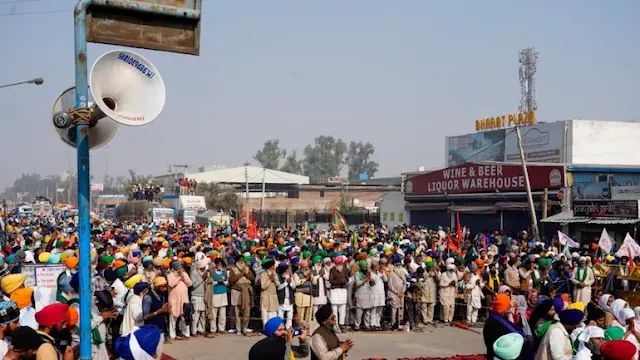Hundreds of thousands of farmers marching from Punjab have laid siege to entry points to Delhi. What are their demands and why the Centre considers some of them untenable?
 |
| Farmers' protest at the Singhu borde |
The scale of the November 26 protest march by 20-odd farmers’ groups of Punjab to New Delhi has perhaps taken both central agencies as well as the Punjab leadership of the BJP by surprise. Members of the farmers’ organisations were headed for Delhi to stage a dharna in the national capital and build pressure on the BJP-led Union government against what they consider as contentious provisions in the new central farm laws. The agitation has seen an estimated 200,000-300,000 farmers converging at various entry points to Delhi.Protests against the central farm laws began in Punjab soon after they were passed by Parliament in September. Members of 31 farmer organisations of Punjab, which represent nearly one million farmers in the state, have been blocking highways and railway tracks passing through the state since September 22. These laws have, among other things, paved the way for farmers to sell their crops anywhere in the country—both within and outside APMC (Agricultural Produce Market Committee) markets—and allows them to go for direct contracts with traders and food processors.
However, Punjab’s farmers, the biggest beneficiary of the Centre’s wheat and paddy procurement, fear that these laws will harm their interests. They fear that central agencies, such as the Food Corporation of India (FCI), might gradually scale down food procurement targets, and even PDS (Public Distribution System) allotments may eventually move to the direct benefit transfer system. PDS alone accounts for about 80 per cent of the FCI’s outflow, along with ‘right to food’, mid-day meals and other social schemes.
Around 85 per cent of Punjab’s yield coming to the market is procured by FCI. In the last Rabi and Kharif seasons, central procurement agencies bought grains worth Rs 54,000 crore from farmers in Punjab. Farmers are insistent that procurement and purchase of their produce at MSP (Minimum Support Price) rates be made mandatory. The Union agriculture ministry does not find this a practical option.
On November 13, farmer leaders from Punjab had met defence minister Rajnath Singh, agriculture minister Narendra Singh Tomar and consumer affairs and food & public distribution minister Piyush Goyal to try and resolve the contentious issues, and both sides had agreed to meet again and continue the dialogue. It seemed like the agitation had been defused when, on November 18, farmers lifted their road and rail blockades and agreed to meet central representatives on December 3.
Among the farmers’ demands are making purchase of all crops at MSP rates mandatory; setting up of special tribunals and courts for redressal of grievances instead of ‘consolation boards’ created under the local SDM (sub-divisional magistrate), with the local district collector as the appellate authority; and cheaper access to storage facilities. The central government has agreed to work on most of the demands and make them part of the rules—which will need Parliament’s approval—except that of making purchases on MSP rates mandatory.
Both Prime Minister Narendra Modi and Tomar have clarified that FCI would continue to procure wheat and paddy from farmers in Punjab, Haryana, western Uttar Pradesh, Madhya Pradesh and other states. The Centre’s argument is that the new laws will make even other crops, beyond wheat and paddy, more viable and make trading in them easier. But farmers’ groups in Punjab remain unconvinced.
The Haryana government’s police deployment to try and stop the agitating farmers from marching towards Delhi led to a war of words between the state’s chief minister Manohar Lal Khattar and his Punjab counterpart Amarinder Singh. Amarinder sought to know why Haryana was preventing farmers from proceeding towards Delhi.
One of the worries has been that the marching farmers were moving with large supplies of ration, leading to apprehensions that this could be a protracted agitation. The farmers have already finished sowing their Rabi crop and are technically free for the next two months, before the spraying of next round of insecticides begins.
On November 28, Union home minister Amit Shah took charge of the situation and began directly speaking to the farmers’ organisations, whose members are camping outside the national capital. He urged them to shift to the designated protest grounds in Burari and initiate dialogue even before the scheduled December 3 talks.
Given its limited representation among the farming communities in Punjab, the state BJP has not been able to prevent the farmers’ protest from scaling up like this. The state BJP unit has cadre only in 4,500 of the 12,500 villages, with almost no leaders among the Jat community. For the past 23 years, the party was dependent on its erstwhile NDA partner, the Shiromani Akali Dal (SAD), for the same. The SAD walked out of the NDA in September in protest against the central farm laws.
BJP leaders accuse Amarinder of inciting the farmers with misinformation and creating a law and order situation, first in Punjab and now in the National Capital Region. While Amarinder has backed the farmers’ protests, the Punjab BJP cannot entirely blame him for the crisis, as the party’s central leadership, too, took its own time to react to the farmers’ agitation. Tomar was busy with the bypolls in his pocket borough of Morena-Chambal-Gwalior in Madhya Pradesh. It was Goyal who was engaging with the farmer leaders as well as affiliates of the RSS on this issue.
It was Punjab BJP leader Surjit Jayani who strengthened the negotiation channels with the farmers and, with the help of Rajnath Singh, brought the leaders back to dialogue table. With entry points to Delhi blocked, farmer leaders are aware that this is creating pressure on the Centre. Now, whether this will provide them a bargaining chip in the dialogue remains to be seen.













0 Comments:
Post a Comment